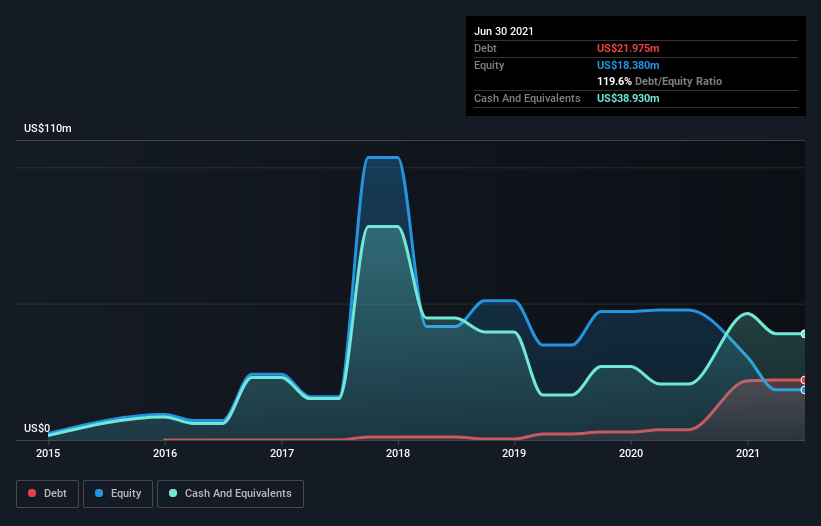Legendary fund manager Li Lu (who Charlie Munger backed) once said, 'The biggest investment risk is not the volatility of prices, but whether you will suffer a permanent loss of capital.' So it might be obvious that you need to consider debt, when you think about how risky any given stock is, because too much debt can sink a company. Importantly, Fluence Corporation Limited (ASX:FLC) does carry debt. But the more important question is: how much risk is that debt creating?
Why Does Debt Bring Risk?
Generally speaking, debt only becomes a real problem when a company can't easily pay it off, either by raising capital or with its own cash flow. Ultimately, if the company can't fulfill its legal obligations to repay debt, shareholders could walk away with nothing. While that is not too common, we often do see indebted companies permanently diluting shareholders because lenders force them to raise capital at a distressed price. By replacing dilution, though, debt can be an extremely good tool for businesses that need capital to invest in growth at high rates of return. When we think about a company's use of debt, we first look at cash and debt together.
View our latest analysis for Fluence
How Much Debt Does Fluence Carry?
You can click the graphic below for the historical numbers, but it shows that as of June 2021 Fluence had US$22.0m of debt, an increase on US$3.75m, over one year. However, it does have US$38.9m in cash offsetting this, leading to net cash of US$17.0m.

How Strong Is Fluence's Balance Sheet?
According to the last reported balance sheet, Fluence had liabilities of US$93.9m due within 12 months, and liabilities of US$33.0m due beyond 12 months. Offsetting these obligations, it had cash of US$38.9m as well as receivables valued at US$27.4m due within 12 months. So its liabilities outweigh the sum of its cash and (near-term) receivables by US$60.5m.
This is a mountain of leverage relative to its market capitalization of US$72.0m. This suggests shareholders would be heavily diluted if the company needed to shore up its balance sheet in a hurry. Despite its noteworthy liabilities, Fluence boasts net cash, so it's fair to say it does not have a heavy debt load! When analysing debt levels, the balance sheet is the obvious place to start. But it is future earnings, more than anything, that will determine Fluence's ability to maintain a healthy balance sheet going forward. So if you want to see what the professionals think, you might find this free report on analyst profit forecasts to be interesting.
In the last year Fluence had a loss before interest and tax, and actually shrunk its revenue by 7.7%, to US$83m. We would much prefer see growth.
So How Risky Is Fluence?
Although Fluence had an earnings before interest and tax (EBIT) loss over the last twelve months, it generated positive free cash flow of US$17m. So although it is loss-making, it doesn't seem to have too much near-term balance sheet risk, keeping in mind the net cash. Until we see some positive EBIT, we're a bit cautious of the stock, not least because of the rather modest revenue growth. The balance sheet is clearly the area to focus on when you are analysing debt. But ultimately, every company can contain risks that exist outside of the balance sheet. Be aware that Fluence is showing 2 warning signs in our investment analysis , you should know about...
Of course, if you're the type of investor who prefers buying stocks without the burden of debt, then don't hesitate to discover our exclusive list of net cash growth stocks, today.
New: AI Stock Screener & Alerts
Our new AI Stock Screener scans the market every day to uncover opportunities.
• Dividend Powerhouses (3%+ Yield)
• Undervalued Small Caps with Insider Buying
• High growth Tech and AI Companies
Or build your own from over 50 metrics.
This article by Simply Wall St is general in nature. We provide commentary based on historical data and analyst forecasts only using an unbiased methodology and our articles are not intended to be financial advice. It does not constitute a recommendation to buy or sell any stock, and does not take account of your objectives, or your financial situation. We aim to bring you long-term focused analysis driven by fundamental data. Note that our analysis may not factor in the latest price-sensitive company announcements or qualitative material. Simply Wall St has no position in any stocks mentioned.
Have feedback on this article? Concerned about the content? Get in touch with us directly. Alternatively, email editorial-team (at) simplywallst.com.
About ASX:FLC
Fluence
Provides smart water and wastewater treatment solutions for the municipal, commercial, and industrial markets worldwide.
Undervalued with reasonable growth potential.
Similar Companies
Market Insights
Community Narratives



